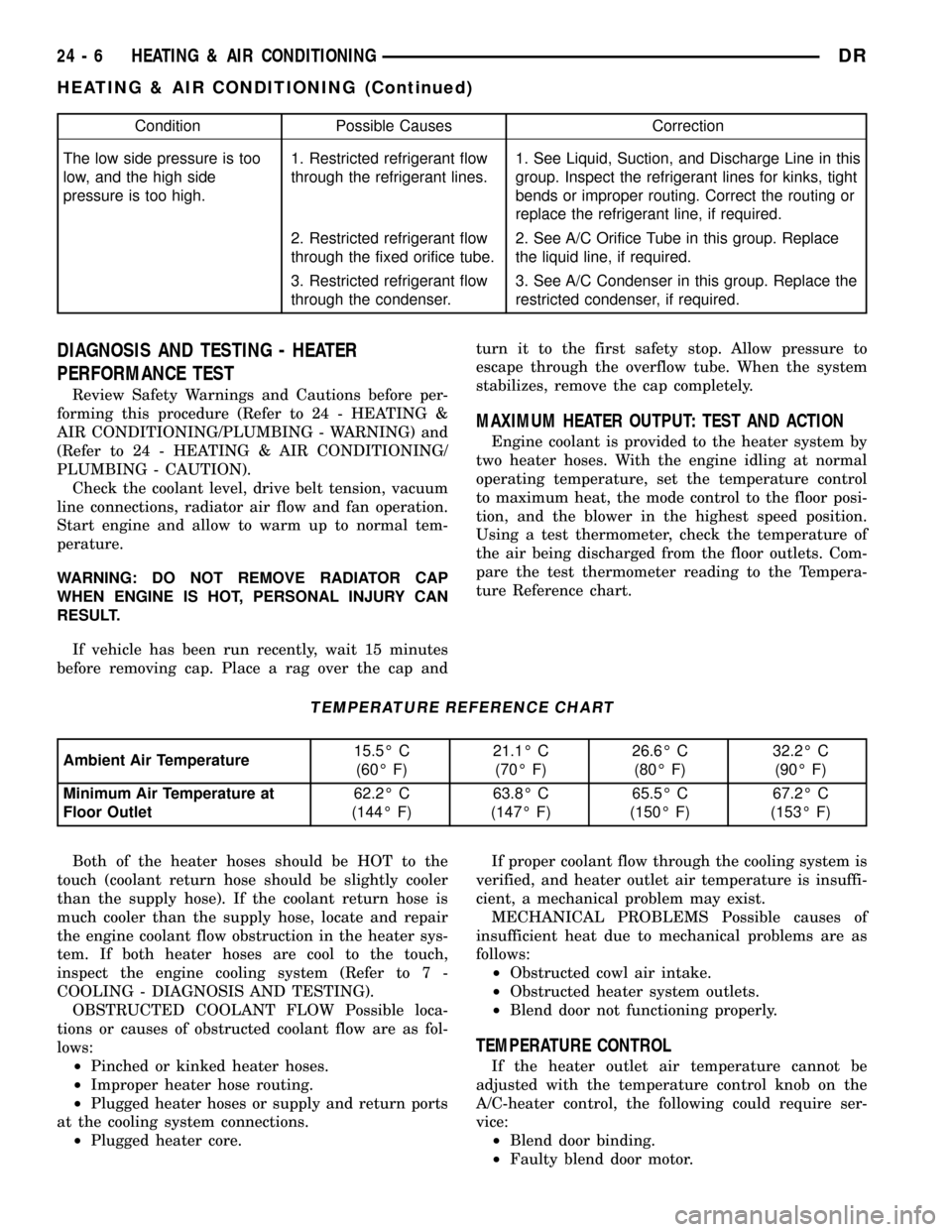1998 DODGE RAM 1500 warning light
[x] Cancel search: warning lightPage 2493 of 2627

Condition Possible Causes Correction
The low side pressure is too
low, and the high side
pressure is too high.1. Restricted refrigerant flow
through the refrigerant lines.1. See Liquid, Suction, and Discharge Line in this
group. Inspect the refrigerant lines for kinks, tight
bends or improper routing. Correct the routing or
replace the refrigerant line, if required.
2. Restricted refrigerant flow
through the fixed orifice tube.2. See A/C Orifice Tube in this group. Replace
the liquid line, if required.
3. Restricted refrigerant flow
through the condenser.3. See A/C Condenser in this group. Replace the
restricted condenser, if required.
DIAGNOSIS AND TESTING - HEATER
PERFORMANCE TEST
Review Safety Warnings and Cautions before per-
forming this procedure (Refer to 24 - HEATING &
AIR CONDITIONING/PLUMBING - WARNING) and
(Refer to 24 - HEATING & AIR CONDITIONING/
PLUMBING - CAUTION).
Check the coolant level, drive belt tension, vacuum
line connections, radiator air flow and fan operation.
Start engine and allow to warm up to normal tem-
perature.
WARNING: DO NOT REMOVE RADIATOR CAP
WHEN ENGINE IS HOT, PERSONAL INJURY CAN
RESULT.
If vehicle has been run recently, wait 15 minutes
before removing cap. Place a rag over the cap andturn it to the first safety stop. Allow pressure to
escape through the overflow tube. When the system
stabilizes, remove the cap completely.
MAXIMUM HEATER OUTPUT: TEST AND ACTION
Engine coolant is provided to the heater system by
two heater hoses. With the engine idling at normal
operating temperature, set the temperature control
to maximum heat, the mode control to the floor posi-
tion, and the blower in the highest speed position.
Using a test thermometer, check the temperature of
the air being discharged from the floor outlets. Com-
pare the test thermometer reading to the Tempera-
ture Reference chart.
TEMPERATURE REFERENCE CHART
Ambient Air Temperature15.5É C
(60É F)21.1É C
(70É F)26.6É C
(80É F)32.2É C
(90É F)
Minimum Air Temperature at
Floor Outlet62.2É C
(144É F)63.8É C
(147É F)65.5É C
(150É F)67.2É C
(153É F)
Both of the heater hoses should be HOT to the
touch (coolant return hose should be slightly cooler
than the supply hose). If the coolant return hose is
much cooler than the supply hose, locate and repair
the engine coolant flow obstruction in the heater sys-
tem. If both heater hoses are cool to the touch,
inspect the engine cooling system (Refer to 7 -
COOLING - DIAGNOSIS AND TESTING).
OBSTRUCTED COOLANT FLOW Possible loca-
tions or causes of obstructed coolant flow are as fol-
lows:
²Pinched or kinked heater hoses.
²Improper heater hose routing.
²Plugged heater hoses or supply and return ports
at the cooling system connections.
²Plugged heater core.If proper coolant flow through the cooling system is
verified, and heater outlet air temperature is insuffi-
cient, a mechanical problem may exist.
MECHANICAL PROBLEMS Possible causes of
insufficient heat due to mechanical problems are as
follows:
²Obstructed cowl air intake.
²Obstructed heater system outlets.
²Blend door not functioning properly.
TEMPERATURE CONTROL
If the heater outlet air temperature cannot be
adjusted with the temperature control knob on the
A/C-heater control, the following could require ser-
vice:
²Blend door binding.
²Faulty blend door motor.
24 - 6 HEATING & AIR CONDITIONINGDR
HEATING & AIR CONDITIONING (Continued)
Page 2508 of 2627

cal indexing to the defrost door, as it is electronically
calibrated by the heater-A/C control module. The
defrost door actuator cannot be adjusted or repaired
and, if damaged or faulty, it must be replaced.
OPERATION
The defrost door actuator is connected to the heat-
er-A/C control module through the vehicle electrical
system by a dedicated two-wire lead and connector
from the HVAC wire harness. The defrost door actua-
tor can move the defrost door in two directions.
When the heater-A/C control module pulls the volt-
age on one side of the motor connection high and the
other connection low, the defrost door will move in
one direction. When the module reverses the polarity
of the voltage to the motor, the defrost door moves in
the opposite direction. When the module makes the
voltage to both connections high or both connections
low, the defrost door stops and will not move. These
same motor connections also provide a feedback sig-
nal to the heater-A/C control module. This feedback
signal allows the module to monitor the operation
and relative positions of the defrost door actuator
and the defrost door. The heater-A/C control module
learns the defrost door stop positions during the cal-
ibration procedure and will store a Diagnostic Trou-
ble Code (DTC) for any problems it detects in the
defrost door actuator circuits. The defrost door actua-
tor can be diagnosed using a DRBIIItscan tool.
Refer to Body Diagnostic Procedures.
REMOVAL
WARNING: ON VEHICLES EQUIPPED WITH AIR-
BAGS, DISABLE THE AIRBAG SYSTEM BEFORE
ATTEMPTING ANY STEERING WHEEL, STEERING
COLUMN, OR INSTRUMENT PANEL COMPONENT
DIAGNOSIS OR SERVICE. DISCONNECT AND ISO-
LATE THE BATTERY NEGATIVE (GROUND) CABLE,
THEN WAIT TWO MINUTES FOR THE AIRBAG SYS-
TEM CAPACITOR TO DISCHARGE BEFORE PER-
FORMING FURTHER DIAGNOSIS OR SERVICE. THIS
IS THE ONLY SURE WAY TO DISABLE THE AIRBAG
SYSTEM. FAILURE TO TAKE THE PROPER PRE-
CAUTIONS COULD RESULT IN AN ACCIDENTAL
AIRBAG DEPLOYMENT AND POSSIBLE PERSONAL
INJURY.
(1) Disconnect and isolate the battery negative
cable.
(2) Remove the instrument panel from the vehicle
(Refer to 23 - BODY/INSTRUMENT PANEL/IN-
STRUMENT PANEL ASSEMBLY - REMOVAL).
(3) Disconnect the wire harness connector from the
defrost door actuator (Fig. 19).
(4) Remove the screws that secure the defrost door
actuator to the HVAC housing.(5) Remove the defrost door actuator from the
HVAC housing.
INSTALLATION
(1) Position the defrost door actuator into the
HVAC housing. If necessary, rotate the actuator
slightly to align the splines on the actuator output
sleeve with those on the defrost door linkage.
(2) Install and tighten the screws that secure the
defrost door actuator to the HVAC housing. Tighten
the screws to 2 N´m (17 in. lbs.).
(3) Connect the HVAC wire harness connector to
the defrost door actuator.
(4) Install the instrument panel (Refer to 23 -
BODY/INSTRUMENT PANEL/INSTRUMENT
PANEL ASSEMBLY - INSTALLATION).
(5) Reconnect the battery negative cable.
Fig. 19 HVAC Housing - Dual Zone Shown, Single
Zone Typical
1 - NUT
2 - PASSENGER BLEND DOOR ACTUATOR
3 - NUT
4 - INLET BAFFLE
5 - RECIRCULATION DOOR ACTUATOR
6 - RECIRCULATION DOOR
7 - DRIVER SIDE BLEND DOOR ACTUATOR
8 - HVAC HOUSING
9 - BOLT
10 - DEFROSTER DOOR ACTUATOR
11 - MODE DOOR ACTUATOR
DRCONTROLS 24 - 21
DEFROST DOOR ACTUATOR (Continued)
Page 2510 of 2627

(2) Assemble the HVAC housing (Refer to 24 -
HEATING & AIR CONDITIONING/DISTRIBUTION/
HVAC HOUSING - ASSEMBLY).
(3) Connect the HVAC wire harness connector to
the evaporator temperature sensor.
(4) Install the HVAC housing (Refer to 24 - HEAT-
ING & AIR CONDITIONING/DISTRIBUTION/HVAC
HOUSING - INSTALLATION).
(5) Reconnect the battery negative cable.
MODE DOOR ACTUATOR
DESCRIPTION
The mode door actuator is a reversible 12-volt
Direct Current (DC) servo motor. The mode door
actuator is located on the HVAC housing, behind the
instrument panel and is mechanically connected to
the mode door.
The mode door actuator is interchangeable with
the actuators for the blend door(s), defrost door and
the recirculation door. Each actuator is contained
within an identical black molded plastic housing with
an integral wire connector receptacle. Integral
mounting tabs allow the actuator to be secured with
three screws to the HVAC housing. Each actuator
also has an identical output shaft with splines that
connects it to the linkage that drives the proper door.
The mode door actuator does not require mechanical
indexing to the mode door linkage, as it is electroni-
cally calibrated by the heater-A/C control module.
The mode door actuator cannot be adjusted or
repaired and, if damaged or faulty, it must be
replaced.
OPERATION
The mode door actuator is connected to the A/C-
heater control through the vehicle electrical system
by a dedicated two-wire lead and connector from the
HVAC wire harness. The mode door actuator can
move the mode door in two directions. When the A/C-
heater control pulls the voltage on one side of the
motor connection high and the other connection low,
the mode door will move in one direction. When the
A/C-heater control reverses the polarity of the volt-
age to the motor, the mode door moves in the oppo-
site direction. When the A/C-heater control makes
the voltage to both connections high or both connec-
tions low, the mode door stops and will not move.
These same motor connections also provide a feed-
back signal to the A/C-heater control. This feedback
signal allows the A/C-heater control to monitor the
operation and relative position of the mode door
actuator and the mode door. The A/C-heater control
learns the mode door stop positions during the cali-
bration procedure and will store a diagnostic troublecode (DTC) for any problems it detects in the mode
door actuator circuits.
The mode door actuator can be diagnosed using a
DRBIIItscan tool. Refer to Body Diagnostic Proce-
dures for more information. The mode door actuator
cannot be adjusted or repaired and, if damaged or
faulty, it must be replaced.
REMOVAL
WARNING: ON VEHICLES EQUIPPED WITH AIR-
BAGS, DISABLE THE AIRBAG SYSTEM BEFORE
ATTEMPTING ANY STEERING WHEEL, STEERING
COLUMN, OR INSTRUMENT PANEL COMPONENT
DIAGNOSIS OR SERVICE. DISCONNECT AND ISO-
LATE THE BATTERY NEGATIVE (GROUND) CABLE,
THEN WAIT TWO MINUTES FOR THE AIRBAG SYS-
TEM CAPACITOR TO DISCHARGE BEFORE PER-
FORMING FURTHER DIAGNOSIS OR SERVICE. THIS
IS THE ONLY SURE WAY TO DISABLE THE AIRBAG
SYSTEM. FAILURE TO TAKE THE PROPER PRE-
CAUTIONS COULD RESULT IN ACCIDENTAL AIR-
BAG DEPLOYMENT AND POSSIBLE PERSONAL
INJURY.
(1) Disconnect and isolate the battery negative
cable.
(2) Remove the instrument panel from the vehicle
(Refer to 23 - BODY/INSTRUMENT PANEL/IN-
STRUMENT PANEL ASSEMBLY - REMOVAL).
(3) Disconnect the wire harness connector from the
mode door actuator (Fig. 22).
(4) Remove the screws that secure the mode door
actuator to the HVAC housing.
(5) Remove the mode door actuator from the HVAC
housing.
INSTALLATION
(1) Position the mode door actuator onto the HVAC
housing. If necessary, rotate the actuator slightly to
align the splines on the actuator output sleeve with
those on the mode door linkage.
(2) Install and tighten the screws that secure the
mode door actuator to the HVAC housing. Tighten
the screws to 2 N´m (17 in. lbs.).
(3) Connect the HVAC wire harness connector to
the mode door actuator.
(4) Install the instrument panel (Refer to 23 -
BODY/INSTRUMENT PANEL/INSTRUMENT
PANEL ASSEMBLY - INSTALLATION).
(5) Reconnect the battery negative cable.
DRCONTROLS 24 - 23
EVAPORATOR TEMPERATURE SENSOR (Continued)
Page 2514 of 2627

NOTE: The instrument panel air outlets are retained
into the outlet housings by a light snap fit.
(1) Using a trim stick or another suitable wide
flat-bladed tool, gently pry the panel air outlet(s) out
of the panel outlet housing(s) as required (Fig. 1).
INSTALLATION
(1) Position the air outlet(s) onto the outlet hous-
ing(s).
(2) Gently push the air outlet into the housing
until it snaps into position.
BLEND DOOR
REMOVAL
WARNING: ON VEHICLES EQUIPPED WITH AIR-
BAGS, DISABLE THE AIRBAG SYSTEM BEFORE
ATTEMPTING ANY STEERING WHEEL, STEERING
COLUMN, OR INSTRUMENT PANEL COMPONENT
DIAGNOSIS OR SERVICE. DISCONNECT AND ISO-
LATE THE BATTERY NEGATIVE (GROUND) CABLE,
THEN WAIT TWO MINUTES FOR THE AIRBAG SYS-
TEM CAPACITOR TO DISCHARGE BEFORE PER-
FORMING FURTHER DIAGNOSIS OR SERVICE. THIS
IS THE ONLY SURE WAY TO DISABLE THE AIRBAG
SYSTEM. FAILURE TO TAKE THE PROPER PRE-
CAUTIONS COULD RESULT IN AN ACCIDENTAL
AIRBAG DEPLOYMENT AND POSSIBLE PERSONAL
INJURY.NOTE: Vehicles equiped with single zone HVAC
systems have one blend door, dual zone systems
have two blend doors.
(1) Remove the HVAC housing from the vehicle
(Refer to 24 - HEATING & AIR CONDITIONING/
DISTRIBUTION/HVAC HOUSING - REMOVAL).
(2) Disassemble the HVAC housing (Refer to 24 -
HEATING & AIR CONDITIONING/DISTRIBUTION/
HVAC HOUSING - DISASSEMBLY).
(3) Remove the levers from the driver and/or pas-
senger side blend door (if equipped) (Fig. 2).
(4) Gently slide the drivers and/or passenger side
blend door toward the out side of the housing. Tilt
and lift the door(s) out of the housing.
(5) Inspect the blend door(s), seals and the HVAC
housing for damage or binding and repair or replace
components as required.
INSTALLATION
(1) Position the blend door pivot shafts into the
pivot hole and actuator in the bottom of the lower
half of the HVAC housing.
(2) Install the blend door(s) by carefully tipping
the doors into the HVAC housing, then sliding each
door into it's operating position.
(3) Install the levers to the driver and/or passen-
ger side blend door (if equipped).
(4) Assemble the HVAC housing (Refer to 24 -
HEATING & AIR CONDITIONING/DISTRIBUTION/
HVAC HOUSING - ASSEMBLY)
Fig. 1 Instrument Panel Air Outlets
1 - HEADLIGHT SWITCH
2 - AIR OUTLETS
3 - INSTRUMENT CLUSTER
4 - CLIMATE CONTROL
5 - RADIO
6 - AIRBAG
7 - GLOVE BOX
8 - HEATED SEAT SWITCH (IF EQUIPPED)
9 - TRANSFER CASE SWITCH (IF EQUIPPED)
10 - CIGAR LIGHTER
11 - CUP HOLDERS
12 - ASH TRAY (IF EQUIPPED)
13 - POWER OUTLET
Fig. 2 Blend Door - Dual Zone Shown, Single Zone
Typical
1 - PASSENGER SIDE BLEND DOOR LEVER
2 - PASSENGER SIDE BLEND DOOR
3 - EVAPORATOR TEMPERATURE SENSOR WIRE
4 - HVAC HOUSING
5 - A/C EVAPORATOR
6 - EVAPORATOR TEMPERATURE SENSOR PROBE
7 - DRIVER SIDE BLEND DOOR
8 - DRIVER SIDE BLEND DOOR LEVER
DRDISTRIBUTION 24 - 27
AIR OUTLETS (Continued)
Page 2529 of 2627

REFRIGERANT OIL
DESCRIPTION.........................68
OPERATION...........................69
STANDARD PROCEDURE - REFRIGERANT
OIL LEVEL...........................69
SERVICE PORT VALVE CORE
DESCRIPTION.........................70
REMOVAL - SERVICE PORT VALVE CORES . . 70
INSTALLATION.........................70
SUCTION LINE
DESCRIPTION.........................70REMOVAL
REMOVAL - 5.9L DIESEL ENGINE.........70
REMOVAL - 3.7L/4.7L AND 5.7L HEMI
ENGINE.............................71
INSTALLATION
INSTALLATION - 5.9L DIESEL ENGINE.....72
INSTALLATION - 3.7L/4.7L AND 5.7L HEMI
ENGINE.............................73
PLUMBING
DESCRIPTION - REFRIGERANT LINE
The refrigerant lines and hoses are used to carry
the refrigerant between the various air conditioning
system components. A barrier hose design with a
nylon tube, which is sandwiched between rubber lay-
ers, is used for the R-134a air conditioning system on
this vehicle. This nylon tube helps to further contain
the R-134a refrigerant, which has a smaller molecu-
lar structure than R-12 refrigerant. The ends of the
refrigerant hoses are made from lightweight alumi-
num or steel, and commonly use braze-less fittings.
Any kinks or sharp bends in the refrigerant plumb-
ing will reduce the capacity of the entire air condi-
tioning system. Kinks and sharp bends reduce the
flow of refrigerant in the system. A good rule for the
flexible hose refrigerant lines is to keep the radius of
all bends at least ten times the diameter of the hose.
In addition, the flexible hose refrigerant lines should
be routed so they are at least 80 millimeters (3
inches) from an exhaust manifold.
OPERATION- REFRIGERANT LINES
High pressures are produced in the refrigerant sys-
tem when the air conditioning compressor is operat-
ing. Extreme care must be exercised to make sure
that each of the refrigerant system connections is
pressure-tight and leak free. It is a good practice to
inspect all flexible hose refrigerant lines at least once
a year to make sure they are in good condition and
properly routed.
The refrigerant lines and hoses are coupled with
other components of the HVAC system with either
O-rings or dual plane seals.
The refrigerant lines and hoses cannot be repaired
and, if faulty or damaged, they must be replaced.
WARNING
ENGINE COOLING SYSTEM
WARNING: THE ENGINE COOLING SYSTEM IS
DESIGNED TO DEVELOP INTERNAL PRESSURES
OF 97 TO 123 KILOPASCALS (14 TO 18 POUNDS
PER SQUARE INCH). DO NOT REMOVE OR
LOOSEN THE COOLANT PRESSURE CAP, CYLIN-
DER BLOCK DRAIN PLUGS, RADIATOR DRAIN,
RADIATOR HOSES, HEATER HOSES, OR HOSE
CLAMPS WHILE THE ENGINE COOLING SYSTEM IS
HOT AND UNDER PRESSURE. FAILURE TO
OBSERVE THIS WARNING CAN RESULT IN SERI-
OUS BURNS FROM THE HEATED ENGINE COOL-
ANT. ALLOW THE VEHICLE TO COOL FOR A
MINIMUM OF 15 MINUTES BEFORE OPENING THE
COOLING SYSTEM FOR SERVICE.
24 - 42 PLUMBINGDR
Page 2548 of 2627

DIAGNOSIS AND TESTING - A/C ORIFICE TUBE
WARNING: THE LIQUID LINE BETWEEN THE CON-
DENSER OUTLET AND THE A/C ORIFICE TUBE
CAN BECOME HOT ENOUGH TO BURN THE SKIN.
USE EXTREME CAUTION WHEN PERFORMING THE
FOLLOWING TEST.
NOTE: The A/C orifice tube can be checked for
proper operation using the following procedure.
However, the A/C orifice tube is only serviced as a
part of the liquid line. If the results of this test indi-
cate that the A/C orifice tube is obstructed or miss-
ing, the liquid line must be replaced.
(1) Confirm that the refrigerant system is properly
charged. (Refer to 24 - HEATING & AIR CONDI-
TIONING - DIAGNOSIS AND TESTING - A/C PER-
FORMANCE)
(2) Start the engine. Turn on the air conditioning
system and confirm that the compressor clutch is
engaged.
(3) Allow the air conditioning system to operate for
five minutes.
(4) Lightly and cautiously touch the liquid line
near the condenser outlet at the front of the engine
compartment. The liquid line should be hot to the
touch.
(5) Touch the liquid line near the evaporator inlet
at the rear of the engine compartment. The liquid
line should be cold to the touch.
(6) If there is a distinct temperature differential
between the two ends of the liquid line, the A/C ori-
fice tube is in good condition. If there is little or no
detectable temperature differential between the two
ends of the liquid line, the A/C orifice tube is
obstructed or missing and the liquid line must be
replaced.
ACCUMULATOR
DESCRIPTION
The accumulator (Fig. 21) is mounted in the engine
compartment between the evaporator outlet and the
compressor suction port. An integral mounting
bracket is used to secure the accumulator to the dash
panel.
The accumulator cannot be repaired and, if faulty
or damaged, it must be replaced. The rubber O-rings
are available for service replacement.
OPERATION
Refrigerant enters the accumulator canister as a
low pressure vapor through the inlet tube. Any liq-
uid, oil-laden refrigerant falls to the bottom of thecanister, which acts as a separator. A desiccant bag is
mounted inside the accumulator canister to absorb
any moisture which may have entered and become
trapped within the refrigerant system.
REMOVAL
WARNING: REVIEW THE WARNINGS AND CAU-
TIONS IN THE FRONT OF THIS SECTION BEFORE
PERFORMING THE FOLLOWING OPERATION (Refer
to 24 - HEATING & AIR CONDITIONING/PLUMBING -
WARNING) and (Refer to 24 - HEATING & AIR CON-
DITIONING/PLUMBING - CAUTION).
(1) Disconnect and isolate the battery negative
cable.
(2) Recover the refrigerant from the refrigerant
system (Refer to 24 - HEATING & AIR CONDITION-
Fig. 21 Accumulator - Typical
1 - A/C LOW PRESSURE SWITCH (IF EQUIPPED)
2 - PRESSURE SWITCH FITTING
3 - OUTLET TO COMPRESSOR
4 - ANTI-SIPHON HOLE
5 - DESICCANT BAG
6 - OIL RETURN ORIFICE FILTER
7 - VAPOR RETURN TUBE
8 - ACCUMULATOR DOME
9 - O-RING SEAL
10 - INLET FROM EVAPORATOR
DRPLUMBING 24 - 61
A/C ORIFICE TUBE (Continued)
Page 2552 of 2627

(1) Drain the engine cooling system (Refer to 7 -
COOLING - STANDARD PROCEDURE - COOLING
SYSTEM DRAIN).
(2) Remove the heater hose retaining brackets as
required (depending on engine application).
(3) Using spring tension clamp pliers, compress
and slide the clamps off of each end of the hose being
removed (Fig. 25).
CAUTION: DO NOT apply excessive pressure on
heater tubes or connections when removing heater
hoses. Excessive pressure may damage or deform
the tubes/heater core, causing an engine coolant
leak.
(4) Disconnect each hose end by carefully twisting
the hose back and forth on the tube, while gently
pulling it away from the end of the tube.
(5) If necessary, carefully cut the hose end and
peel the hose off of the tube.
NOTE: Replacement of the heater return hose will
be required if the hose ends are cut for removal.
(6) Remove the heater return hose from the engine
compartment.
(7) Separate the heater hoses from each other as
required (depending on engine application).INSTALLATION
(1) If separated, reconnect the heater hoses to each
other as required (depending on engine application).
(2) Position the heater return hose into the engine
compartment.
(3) Using spring tension clamp pliers, compress
and slide each clamp away from the end of the hose
being installed.
(4) Install each hose by carefully twisting the hose
back and forth while gently pushing it onto the tube
end.
(5) Using spring tension clamp pliers, compress
and slide the clamps onto each end of the hose being
installed.
(6) Install the heater hose retaining brackets as
required (depending on engine application).
(7) Refill the engine cooling system (Refer to 7 -
COOLING - STANDARD PROCEDURE).
LIQUID LINE
DESCRIPTION
The liquid line is the refrigerant line that carries
refrigerant from the A/C condenser to the evaporator.
The liquid line for this model consist of two separate
lines that connect to each other. The liquid lines are
made from light-weight aluminum or steel, and use
braze-less fittings.
The front half of the liquid line contains the fixed
orifice tube. The liquid lines are only serviced as an
assembly, except for the rubber O-ring seals used on
the end fittings. The liquid lines cannot be adjusted
or repaired and, if found to be leaking or damaged,
they must be replaced.
REMOVAL
WARNING: REVIEW THE WARNINGS AND CAU-
TIONS IN THE FRONT OF THIS SECTION BEFORE
PERFORMING THE FOLLOWING OPERATION (Refer
to 24 - HEATING & AIR CONDITIONING/PLUMBING -
WARNING) and (Refer to 24 - HEATING & AIR CON-
DITIONING/PLUMBING - CAUTION).
(1) Disconnect and isolate the battery negative
cable.
(2) If equipped with the diesel engine, remove the
passenger side battery (Refer to 8 - ELECTRICAL/
BATTERY SYSTEM/BATTERY - REMOVAL).
(3) If equipped with the diesel engine, remove the
passenger side battery tray (Refer to 8 - ELECTRI-
CAL/BATTERY SYSTEM/TRAY - REMOVAL).
(4) Recover the refrigerant from the refrigerant
system (Refer to 24 - HEATING & AIR CONDITION-
Fig. 25 Heater Hoses - Typical
1 - HEATER CORE TUBES
2 - HEATER INLET HOSE
3 - RETAINING BRACKET
4 - HOSE CONNECTOR
5 - SPRING CLAMP
6 - HEATER RETURN HOSE
DRPLUMBING 24 - 65
HEATER RETURN HOSE (Continued)
Page 2593 of 2627

CASE - NV271 - DESCRIPTION,
TRANSFER.........................21-447
CASE - NV271 - DIAGNOSIS AND
TESTING, TRANSFER.................21-448
CASE - NV271 - DISASSEMBLY,
TRANSFER.........................21-450
CASE - NV271 - INSPECTION, TRANSFER . 21-459
CASE - NV271 - INSTALLATION,
TRANSFER.........................21-473
CASE - NV271 - OPERATION, TRANSFER . 21-448
CASE - NV271 - REMOVAL, TRANSFER . . 21-450
CASE - NV273 - ASSEMBLY, TRANSFER . . 21-556
CASE - NV273 - CLEANING, TRANSFER . . 21-554
CASE - NV273 - DESCRIPTION,
TRANSFER.........................21-542
CASE - NV273 - DIAGNOSIS AND
TESTING, TRANSFER.................21-543
CASE - NV273 - DISASSEMBLY,
TRANSFER.........................21-544
CASE - NV273 - INSPECTION, TRANSFER . 21-554
CASE - NV273 - INSTALLATION,
TRANSFER.........................21-568
CASE - NV273 - OPERATION, TRANSFER . 21-543
CASE - NV273 - REMOVAL, TRANSFER . . 21-544
CASE BEARINGS - INSTALLATION,
DIFFERENTIAL.....3-106,3-134,3-161,3-48,3-75
CASE BEARINGS - REMOVAL,
DIFFERENTIAL.....3-105,3-134,3-161,3-48,3-75
CASE CONTROL MODULE -
DESCRIPTION, TRANSFER.............8E-16
CASE CONTROL MODULE - OPERATION,
TRANSFER..........................8E-16
CASE, NV241 GENII - TRANSFER.......21-438
CASE, NV241/NV243 - TRANSFER......21-439
CASE, NV243 - TRANSFER......21-505,21-506
CASE, NV244 GENII - TRANSFER.......21-535
CASE, NV271 - TRANSFER............21-473
CASE NV271/NV273, SPECIAL TOOLS -
TRANSFER...................21-474,21-569
CASE, NV273 - TRANSFER............21-568
CASE SKID PLATE - INSTALLATION,
TRANSFER..........................13-26
CASE SKID PLATE - REMOVAL,
TRANSFER..........................13-26
CASTER ADJUSTMENT - STANDARD
PROCEDURE, CAMBER..................2-4
CASTER AND TOE ADJUSTMENT -
STANDARD PROCEDURE, CAMBER........2-4
CATALYTIC CONVERTER - DESCRIPTION . . . 11-6
CATALYTIC CONVERTER - OPERATION.....11-6
CATCH - INSTALLATION, LATCH STRIKER
/ SECONDARY.......................23-48
CATCH - REMOVAL, LATCH STRIKER /
SECONDARY........................23-47
CAUTION - A/C SYSTEM...............24-43
CAUTION, HALF SHAFT.................3-20
CAUTION, INTERIOR..................23-62
CENTER - DESCRIPTION, ELECTRONIC
VEHICLE INFO.......................8M-7
CENTER - DIAGNOSIS AND TESTING,
ELECTRONIC VEHICLE INFORMATION.....8M-8
CENTER - INSTALLATION, ELECTRONIC
VEHICLE INFO.......................8M-9
CENTER & LEFT OUTBOARD -
INSTALLATION......................8O-50
CENTER & LEFT OUTBOARD - REMOVAL
. . 8O-48
CENTER - OPERATION, ELECTRONIC
VEHICLE INFO
.......................8M-7
CENTER - REMOVAL, ELECTRONIC
VEHICLE INFO
.......................8M-9
CENTER ANCHOR & RIGHT OUTBOARD -
INSTALLATION
......................8O-50
CENTER ANCHOR & RIGHT OUTBOARD -
REMOVAL
..........................8O-49
CENTER ARMREST / SEAT BACK -
INSTALLATION
.......................23-77
CENTER ARMREST / SEAT BACK -
REMOVAL
..........................23-76
CENTER BEARING - ADJUSTMENTS
........3-9
CENTER BEARING - INSTALLATION
........3-9
CENTER BEARING - REMOVAL
............3-9
CENTER BEZEL - INSTALLATION,
INSTRUMENT PANEL
..................23-57
CENTER BEZEL - REMOVAL,
INSTRUMENT PANEL
..................23-57
CENTER HIGH MOUNTED STOP LAMP -
INSTALLATION
.......................8L-11CENTER HIGH MOUNTED STOP LAMP -
REMOVAL..........................8L-11
CENTER HIGH MOUNTED STOP LAMP
UNIT - INSTALLATION.................8L-11
CENTER HIGH MOUNTED STOP LAMP
UNIT - REMOVAL....................8L-11
CENTER PROGRAMMING - STANDARD
PROCEDURE, ELECTRONIC VEHICLE
INFORMATION.......................8M-8
CENTER SEAT - INSTALLATION..........23-76
CENTER SEAT - REMOVAL.............23-75
CENTER SEAT BACK HINGE -
INSTALLATION.......................23-79
CENTER SEAT BACK HINGE - REMOVAL . . . 23-78
CENTER SEAT BACK INERTIA HINGE
COVER - INSTALLATION...............23-77
CENTER SEAT BACK INERTIA HINGE
COVER - REMOVAL...................23-77
CENTER SEAT BACK LID - INSTALLATION . 23-79
CENTER SEAT BACK LID - REMOVAL.....23-79
CENTER SEAT BELT - INSTALLATION,
FRONT.............................8O-31
CENTER SEAT BELT - REMOVAL, FRONT . . 8O-30
CENTER SEAT BELT & RETRACTOR -
INSTALLATION, FRONT................8O-29
CENTER SEAT BELT & RETRACTOR -
INSTALLATION, REAR.................8O-45
CENTER SEAT BELT & RETRACTOR -
REMOVAL, FRONT....................8O-29
CENTER SEAT BELT & RETRACTOR -
REMOVAL, REAR....................8O-44
CENTER SEAT CUSHION - INSTALLATION . . . 23-79
CENTER SEAT CUSHION - REMOVAL.....23-79
CENTER SEAT CUSHION COVER -
INSTALLATION.......................23-79
CENTER SEAT CUSHION COVER -
REMOVAL..........................23-79
CENTERING - STANDARD PROCEDURE,
CLOCKSPRING......................8O-19
CERTIFICATION LABEL - DESCRIPTION,
VEHICLE.........................Intro.-11
CHAIN COVER(S) - INSTALLATION,
TIMING BELT....................9-171,9-81
CHAIN COVER(S) - REMOVAL, TIMING
BELT ..........................9-170,9-81
CHAIN WEAR - STANDARD PROCEDURE,
MEASURING TIMING..................9-167
CHAIN WEAR, STANDARD PROCEDURE -
MEASURING TIMING...................9-77
CHAIN/TENSIONER - DESCRIPTION,
TIMING............................9-229
CHAIN/TENSIONER - OPERATION,
TIMING............................9-229
CHANNEL - INSTALLATION, GLASS RUN . . 23-22,
23-31
CHANNEL - REMOVAL, GLASS RUN . 23-21,23-30
CHARGE - STANDARD PROCEDURE,
REFRIGERANT SYSTEM...............24-47
CHARGE AIR COOLER AND PLUMBING -
CLEANING..........................11-17
CHARGE AIR COOLER AND PLUMBING -
DESCRIPTION.......................11-16
CHARGE AIR COOLER AND PLUMBING -
INSPECTION........................11-17
CHARGE AIR COOLER AND PLUMBING -
INSTALLATION.......................11-17
CHARGE AIR COOLER AND PLUMBING -
OPERATION
.........................11-16
CHARGE AIR COOLER AND PLUMBING -
REMOVAL
..........................11-17
CHARGE AIR COOLER SYSTEM - LEAKS
- DIAGNOSIS AND TESTING
............11-16
CHARGING - DESCRIPTION
.............8F-19
CHARGING - OPERATION
..............8F-19
CHARGING - STANDARD PROCEDURE,
BATTERY
............................8F-8
CHARGING SYSTEM - DIAGNOSIS AND
TESTING
...........................8F-19
CHARGING SYSTEM - SPECIFICATIONS,
TORQUE - GENERATOR
................8F-20
CHART - SPECIFICATIONS, TORQUE
........5-8
CHART, SPECIFICATIONS - TORQUE
.......5-46
CHART, SPECIFICATIONS - TORQUE
.....19-19,
19-23,19-35,19-42
CHART, SPECIFICATIONS - TORQUE
. . 2-10,2-29,
2-42
CHART, SPECIFICATIONS - TORQUE
......22-13CHARTS - DIAGNOSIS AND TESTING,
DIAGNOSIS........................21-145
CHARTS - DIAGNOSIS AND TESTING,
SMOKE DIAGNOSIS...................9-236
CHECK - STANDARD PROCEDURE,
COOLANT LEVEL......................7-17
CHECK - STANDARD PROCEDURE, FLUID
LEVEL......................21-202,21-366
CHECK - STANDARD PROCEDURE, OIL
PUMP VOLUME.....................21-387
CHECK CABLE - INSTALLATION.........23-15
CHECK CABLE - REMOVAL.............23-15
CHECK GAUGES INDICATOR -
DESCRIPTION.......................8J-21
CHECK GAUGES INDICATOR -
OPERATION.........................8J-21
CHECK VALVE - DESCRIPTION...........8R-7
CHECK VALVE - INSTALLATION..........8R-8
CHECK VALVE - OPERATION.............8R-8
CHECK VALVE - REMOVAL..............8R-8
CHILD RESTRAINT ANCHOR -
DESCRIPTION.......................8O-15
CHILD RESTRAINT ANCHOR -
INSTALLATION......................8O-18
CHILD RESTRAINT ANCHOR -
OPERATION.........................8O-17
CHILD RESTRAINT ANCHOR - REMOVAL . . 8O-17
CHIME WARNING SYSTEM -
DESCRIPTION........................8B-1
CHIME WARNING SYSTEM - DIAGNOSIS
AND TESTING........................8B-3
CHIME WARNING SYSTEM - OPERATION . . . 8B-1
CIGAR LIGHTER OUTLET -
DESCRIPTION.....................8W-97-2
CIGAR LIGHTER OUTLET - DIAGNOSIS
AND TESTING.....................8W-97-2
CIGAR LIGHTER OUTLET - OPERATION . 8W-97-2
CIRCUIT - DIAGNOSIS AND TESTING,
AMBIENT TEMPERATURE SENSOR......8M-10
CIRCUIT - OPERATION, FUEL DRAIN.....14-67
CIRCUIT ACTUATION TEST MODE -
DESCRIPTION........................25-1
CIRCUIT FUNCTIONS - DESCRIPTION . . 8W-01-6
CIRCUIT INFORMATION - DESCRIPTION . 8W-01-5
CIRCUIT SENSE - DESCRIPTION,
IGNITION...........................8E-10
CIRCUIT SENSE - OPERATION, IGNITION . . 8E-11
CIRCUITS - OPERATION, NON-
MONITORED.........................25-8
CLAMPS - DESCRIPTION, HOSE...........7-3
CLAMPS - OPERATION, HOSE.............7-5
CLEANING/REVERSE FLUSHING -
STANDARD PROCEDURE, COOLING
SYSTEM............................7-17
CLEARANCE - STANDARD PROCEDURE,
CONNECTING ROD BEARING AND
CRANKSHAFT JOURNAL...............9-272
CLEARANCE - STANDARD PROCEDURE,
MAIN BEARING......................9-274
CLEARANCE LAMP - INSTALLATION, CAB . 8L-12
CLEARANCE LAMP - REMOVAL, CAB.....8L-11
CLOCKSPRING - DESCRIPTION.........8O-18
CLOCKSPRING - INSTALLATION.........8O-21
CLOCKSPRING - OPERATION...........8O-19
CLOCKSPRING - REMOVAL............8O-20
CLOCKSPRING CENTERING - STANDARD
PROCEDURE........................8O-19
CLUSTER - ASSEMBLY, INSTRUMENT....8J-15
CLUSTER - DESCRIPTION, INSTRUMENT . . . 8J-2
CLUSTER - DIAGNOSIS AND TESTING,
INSTRUMENT........................8J-10
CLUSTER - DISASSEMBLY, INSTRUMENT . . 8J-14
CLUSTER - INSTALLATION, INSTRUMENT . 8J-16
CLUSTER - OPERATION, INSTRUMENT.....8J-6
CLUSTER - REMOVAL, INSTRUMENT.....8J-14
CLUSTER BEZEL - INSTALLATION........23-49
CLUSTER BEZEL - REMOVAL...........23-49
CLUTCH - 5.9L DIESEL - DESCRIPTION,
FAN DRIVE VISCOUS...................7-52
CLUTCH - 5.9L DIESEL - OPERATION,
FAN DRIVE VISCOUS...................7-52
CLUTCH - ASSEMBLY, FRONT..........21-207
CLUTCH - ASSEMBLY, LOW/REVERSE . . . 21-385
CLUTCH - ASSEMBLY, REAR
...........21-249
CLUTCH - CLEANING, LOW/REVERSE
....21-385
CLUTCH - CLEANING, REAR
...........21-248
CLUTCH - DESCRIPTION, FRONT
.......21-205
CLUTCH - DESCRIPTION, OVERDRIVE
. . . 21-217
6 INDEXDR
Description Group-Page Description Group-Page Description Group-Page